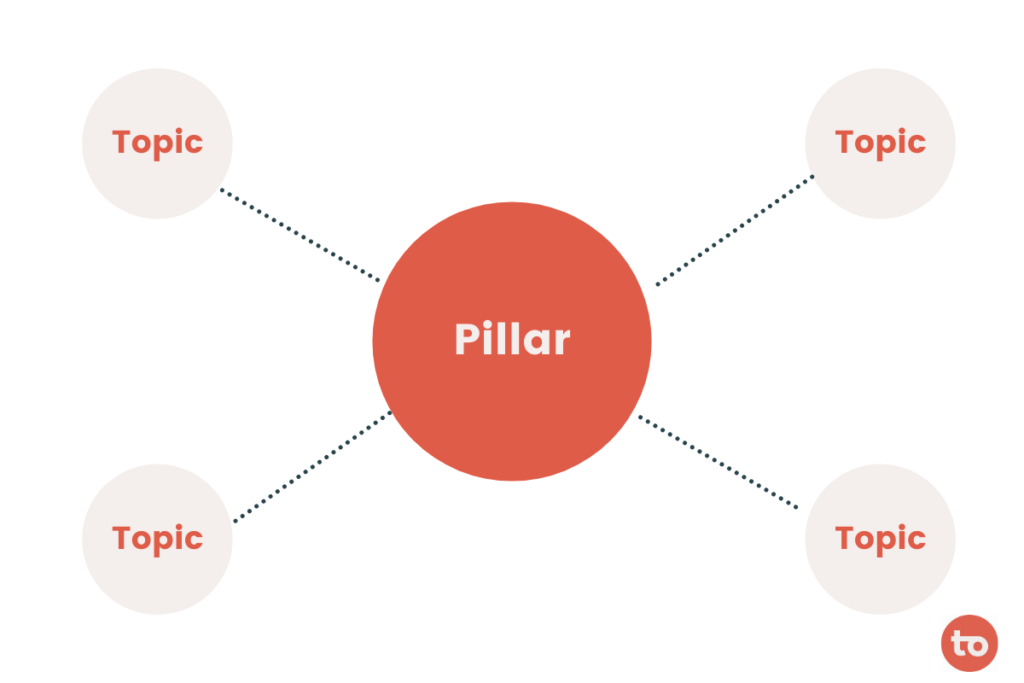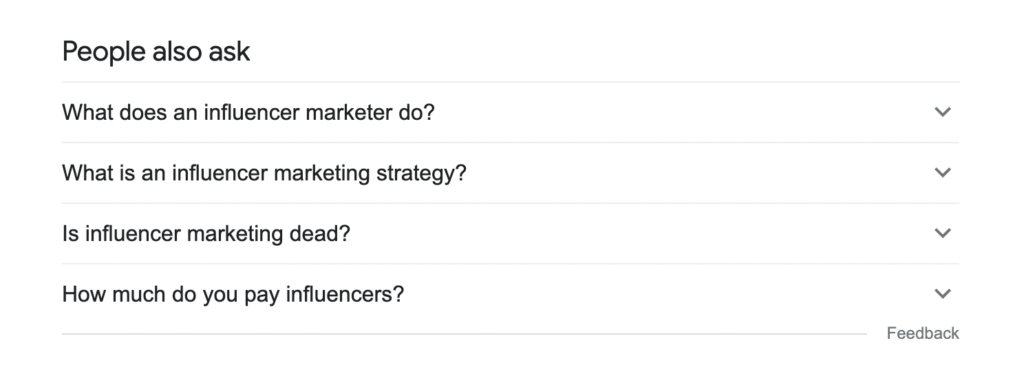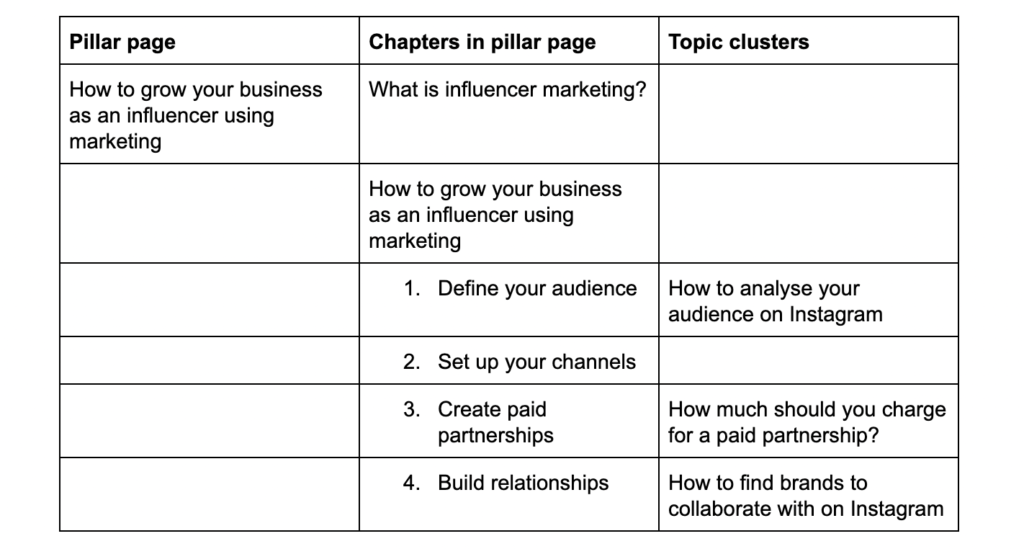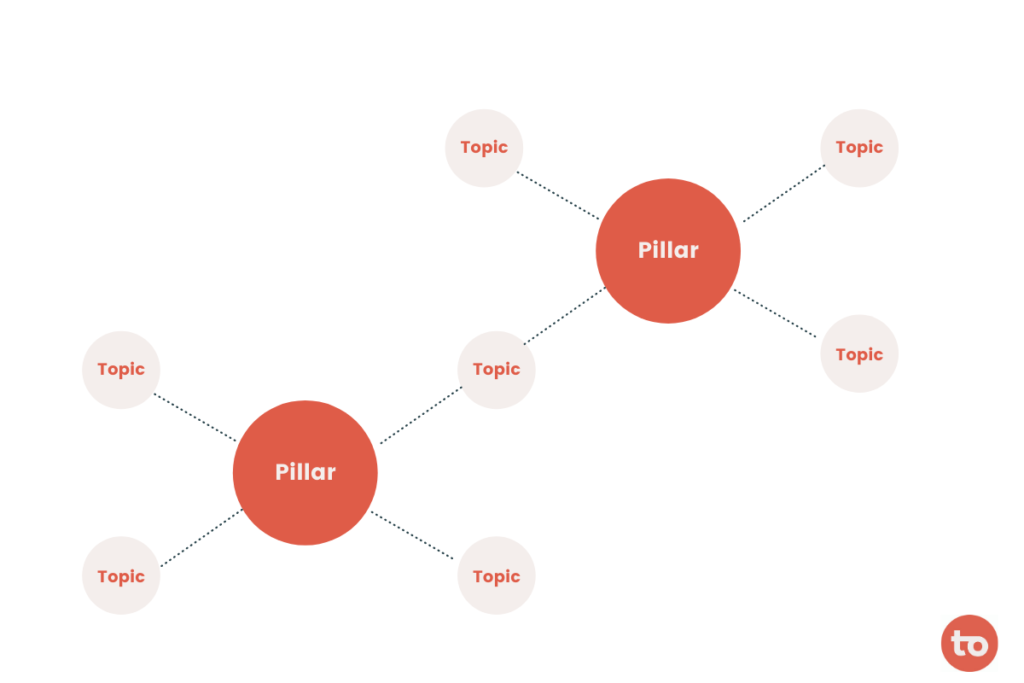Process for Creating a Pillar Page & Topic Cluster Framework
28th March 2021
As many companies now know, a key part of a modern SEO strategy relies on building topical authority in your expert area. This means covering the topic in both breadth and depth, showing that you are the “go to” company and website for that subject matter.
One way to achieve this is through writing about your expert subject area and linking different areas of that topic together on your blog; also known as a pillar page and topic cluster framework.
Below is my guide on how to create a pillar page and content cluster for each of your company’s key topics.

What is a pillar page?
A pillar page simply means the one main page that you want Google to share when someone searches for that top-line term. For example, if you want to build traffic for the term “video marketing”, your pillar page may be How to do video marketing or Video marketing best practices, depending on the angle you take and the amount of key traffic for those terms.
Pillar pages are usually fairly long (around 1000 – 5000 words) and will contain lots of headings and/or jump links to break up the content. They should also include internal links to other blogs that relate to that topic. Which brings us on to….
What is a topic cluster?
A topic cluster is simply another blog. However, while this topic cluster is related to your pillar page topic, it should delve deeper into one specific element or niche idea. Under a topic umbrella, you should only create a topic cluster if you can’t do it justice on the pillar page; if there is too much extra information to cover it well there.
You could also think of your topic cluster as a blog which covers a long tail term. For example, if your pillar page is How to do video marketing, you may have a topic cluster for Top 10 video marketing tools. Each pillar page usually has a series of topic clusters that it will link out to, in order to explore each topic deeper.
Process for creating a pillar page & topic cluster
1. Choose your topic
To begin with, you may only want to have one topic that you cover, or you may have a few different ones.
Think of topics as separate areas of your blog, almost like chapters. In this example, let’s say your company creates a place for YouTube creators to host their video content. The topics you may want to build search traffic for could be:
- Video creation
- Influencer marketing
- Video monetisation
For each of these areas, you would build a pillar page to act as the core blog for that term, and a series of related blogs which would make up your “topic clusters”.
2. Research your topic
Once you have an idea of what your pillar page may be on, the next step is to research your topic.
Here, you are looking for ideas of what to cover based on what users are looking for, what terms there are traffic for, and what other content has already been written on that topic. Search is so competitive these days that you do have to do your research and get more creative with your topics, rather than just repeating what’s already on page one of Google.
In highly competitive markets, creating content for niche topics and long tail terms, which still see 100+ searches per month, is a good strategy to gain visibility.
Sources you might use to research would be:
- Posts already ranking in positions 1-10 for this pillar term – what topics/headings do they cover?
- Google auto suggest and related searches – what related search terms are people searching for? Especially those that aren’t already covered very well in the existing blog content

- Google keyword planner – what are the long-tail terms people are searching for and where do these fit in terms of search volume and competition?
- Quora and Reddit – what questions are people asking around these topics?
Once you have a brainstorm of ideas and research, you can begin to structure this into what should be included within the pillar page, and what needs to be its own topic cluster.
3. Outline your content structure
Below is an example of how I would create a pillar page structure for the topic “Influencer marketing”

Here, you can see that my core “pillar page” for influencer marketing would be How to grow your business as an influencer using marketing. Then, within that blog there would be different chapters covering different areas of this broad topic.
Within those chapters, I would link out text to dive deeper into specific areas. For example, within the chapter around defining an audience, I would link out to How to analyse your audience on Instagram. This would be another blog on my website that would be very specific to Instagram audience analysis.
By creating this structure, I can show Google that I have covered a topic in-depth, in a structural way and that the reader can gain all of the information they need easily around influencer marketing.

Sometimes, your topic cluster may be linked to from more than one pillar page. For example, if I also had a pillar page for A guide to marketing your personal brand on Instagram, it may also be relevant to link out to the blog How to analyse your audience on Instagram as these would also be related topics.
Over to you
The great thing about the pillar page and topic cluster framework is that, not only does it help Google to rank your content more effectively, but it also gives a structure to your content marketing strategy. Helping you to decide what to write and how your content all fits together. Give it a try and let me know how you get on!
